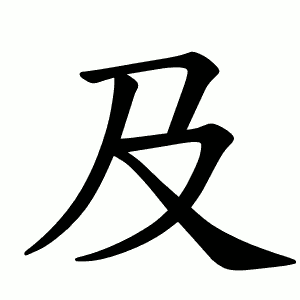及
- to reach, to extend to, to affect;
- to touch;
It is used for ideas like affecting or influencing something, reaching or extending to a point, or arriving somewhere.
Important note: It does not mean “to go insane.”
For the meaning “to go mad,” the character 狂(광) is used.
Etymology
Words that derived from 及
Additional notes
In Korean, 及 also carries the adverbial meaning of “및” (and), similar to and in English.
In Classical Chinese and Modern Chinese literary usage, 及 is frequently used in this “and” sense.
In Japanese, the conjunction 及び (oyobi) comes from the continuative (noun) form of the verb 及ぶ (およぶ, oyobu), meaning “to reach” — and is also used to mean “and.”
The upper part of 急 (급, “urgent”), called 刍, is derived from a modified form of 及 — showing how 及 has served as a base component in later characters.
及
미칠
급
michil
geup
Kangxi radical:29, 又 + 2
Strokes:4
Unicode:U+53CA
Cangjie input:
- 弓竹水 (NHE)
Composition:
- ⿻⿹ ㇋ 丿 乀 (G H J V)
- U +2F836)
- ⿸⿱㇇丿又(TK)
